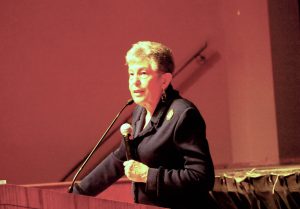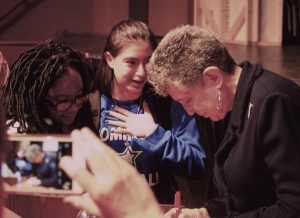Member of ‘Little Rock Nine’ tells of turbulent past
By Kevin Beese Staff reporter — March 4, 2019
Carlotta Walls LaNier, the youngest member of the “Little Rock Nine,” a group of African-American students who were the first black students ever to attend class at Little Rock (Ark.) Central High School as a result of the 1954 U.S. Supreme Court hallmark decision of Brown v. Board of Ed, talks to Hinsdale Central students during a recent program. (Photo by Kevin Beese/Chronicle Media)
When meeting the youngest member of the “Little Rock Nine,” who served as symbols of the Civil Rights Movement, Hinsdale Central student Giselle Castaneda couldn’t hold back the tears.
“I am here today because of women like her,” Castaneda said after meeting Carlotta Walls LaNier. “Because of people like her and my grandmother I was able to enroll in Hinsdale Central.”
Walls LaNier was a member of the “Little Rock Nine,” a group of African-American students who were the first black students ever to attend class at Little Rock (Ark.) Central High School as a result of the U.S. Supreme Court’s hallmark decision in 1954 of Brown v. Board of Ed. She and the eight other black students faced angry mobs, racist elected officials and federal intervention by President Dwight Eisenhower, who was forced to send in the 101st Airborne to escort the nine students into the building.
“We were not the first students to integrate an all-white school,” Walls LaNier said during her Feb. 15 talk at Hinsdale Central High School, “but we were some of the students who got the most attention.”
Walls LaNier said as a grade-school student she was happy when she heard that new books were going to the all-white grade school nearby because she knew “their old books would be going to my school.”
When boundaries were redrawn to allow for the integration of Little Rock Central, Walls LaNier was one of the 119 students who signed up (147 black students were eligible) to attend her neighborhood school. She was one of 39 originally selected for the integration of the high school. That number later became just nine.
“I knew there would be some pushback,” Walls LaNier said of signing up.

Hinsdale Central student Gisselle Castaneda (center) fights back emotions when talking to Walls LaNier while the member of the “Little Rock Nine” signs her book. (Photo by Kevin Beese/Chronicle Media)
She had been the captain of the basketball and cheerleading teams at her school. Entering 10th grade at Little Rock Central, she didn’t figure to be part of those teams her first year at the school, but figured she would join the squads after that. Those opportunities never materialized.
“I didn’t realize until years later that I was going against politicians,” Walls LaNier said.
Walls LaNier said there were three weeks of litigation before she and the other students entered the school on Sept. 25, 1957. Little did she and the other students know that it was the beginning of a journey that would challenge prevailing attitudes, break down barriers and forever change the social landscape of America.
Overcoming her initial need to forget her turbulent past, Walls LaNier has told her story for the first time in the book “A Mighty Long Way: My Journey to Justice at Little Rock Central High School.”
They had tried to bring the students into the building two days earlier but only staffing 17 police officers in the school proved inadequate and the black students were removed within two hours for safety.
Walls LaNier said she and the other black students were isolated from each other and that she only shared one class with another black student.

A copy of Walls LaNier’s book about her experiences in Little Rock’s desegregation. (Photo by Kevin Beese/Chronicle Media)
“I couldn’t miss school,” Walls LaNier said. “There was no one to call about the homework assignments.”
She said she felt very alone at Central that first school year and could not have gotten through it without the support of her family. Walls LaNier labeled her start at Little Rock Central “a tough year.”
She said some of the rhetoric she hears today concerns her.
“A wall is dividing us,” Walls LaNier said. “Our country needs to find itself and get back to the center again.”
Castaneda, a senior at Hinsdale Central, said her grandmother went through racial discrimination when she came to this country, but like Walls LaNier, she persevered.
“If not for people like (Walls LaNier) and my grandmother, I would not have gotten the opportunity to get a scholarship for Dominican University to play softball.” she said.
kbeese@chronicleillinois.com
Like and follow us on Facebook







